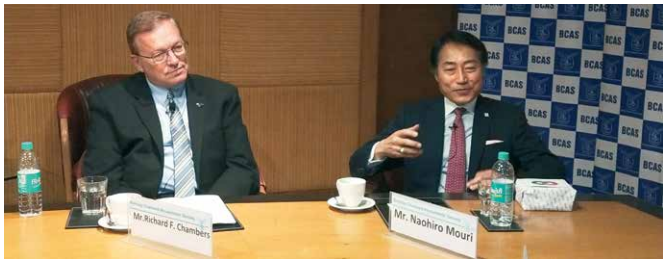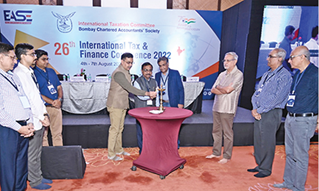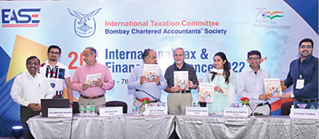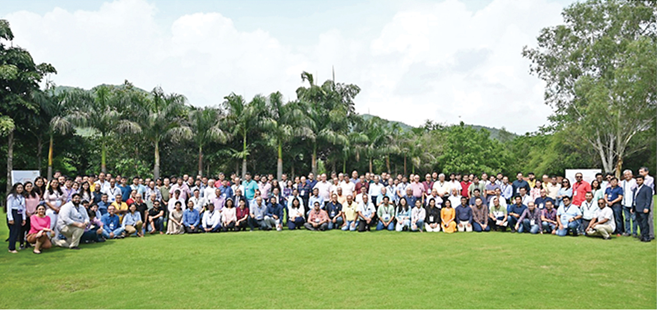Accordingly, Sections 10-13 of the IGST Act, 2017 lay down the rules for determining the place of supply, which in effect will aid in determining the State where the supply is being consumed.
Further, Section 17 lays down the manner of apportionment of tax and settlement of funds, being an integrated tax collected by the Parliament. Since GST works on the principle of value addition and availability of input tax credit for businesses, section 17 recognizes that for a B2B transaction, the tax collected does not accrue to any Government and accordingly provides for settlement of taxes only in cases of B2C transactions and B2B transactions where the corresponding credit is not available.
Section 17 of the IGST Act, 2017 accordingly deals with the following scenarios for the settlement of taxes between the Governments:
a) In respect of supplies made to an unregistered person (B2C)/ composition dealers paying tax u/s 10.
b) In respect of supplies made where the registered person is not entitled to claim the input tax credit.
c) In respect of import of goods/ services by a registered person not entitled to claim the input tax credit.
d) In respect of supplies made where the registered person does not claim input tax credit within the prescribed timelines.
e) In respect of import of goods/ services by a registered person who does not avail the said credit within the prescribed timelines.
f) In respect of import of goods/ services by an unregistered person or a registered person paying tax u/s 10 or a registered person not entitled to claim an input tax credit.
DATA POINTS FOR SETTLEMENT
• GSTR 1: wherein suppliers furnished details of outward supplies made by them to registered / unregistered persons. The details of supplies made to unregistered persons, though to be furnished at summary level, was to be provided supply-wise.
• The supplies to registered taxable persons disclosed in GSTR-1 were intimated to the receiving taxable persons in GSTR-2A.
• Based on the details intimated in GSTR-2A, the receiving taxable person was expected to carry out the matching exercise while furnishing GSTR-2, which is the details of inward supplies and marks each supply as either accepted (i.e., matched), rejected (i.e., incorrectly appearing or requiring amendment) or pending (appearing correctly but not credit eligible in terms of section 16 of the CGST Act, 2017). In addition, the receiving taxable person also had an option to add transactions, not disclosed by the supplier. The input tax credit on such transactions was provisionally subject to the supplier making the necessary rectifications.
• The transactions marked as ‘rejected’ / ‘added’ were to be sent back to the supplier in GSTR-1A whereby they could take the corrective action for the mismatch to be rectified.
• The information furnished in the GSTR-1 and GSTR-2 was to be auto-populated to the GSTR-3 wherein the taxable person was also required to report other adjustments, such as reversal on account of Rules 37, 38, 42, 43, etc., and details of blocked/ ineligible credits and discharge the tax liability by utilizing balances lying in electronic cash/credit ledgers.
The complex transaction-based return cycle was designed to ensure that the data could be collated for proper settlement of taxes among the States.
However, in August 2017, during the first return cycle under GST, the portal displayed unpreparedness to facilitate filing of the above returns. The delay in filing GSTR-3 meant a delay in collection of tax revenue. Therefore, as a makeshift arrangement, the above-detailed process was temporarily substituted by a disjoint process of filing GSTR–1 -> GSTR–3B. It was clarified in the press release that this was to be applicable only for two months where the tax would be payable based on a simple return containing a summary of inward and outward details. However, as time progressed and the portal failed to facilitate the filing of GSTR-2, which delayed the filing of GSTR-3, the proposed filing mechanism was scrapped, and the GSTR-3B replaced GSTR-3 instead of being a mere stop-gap arrangement.
This also meant that the matching process was never implemented on the portal though GSTR–2A was made available to taxpayers. In many cases, basis mismatch between credit claimed in GSTR–3B at a summary level and credit auto-populated in GSTR–2A, recovery notices were issued to the taxpayers alleging an excess claim of the input tax credit. In many cases, the taxpayers were forced to approach the High Court for relief against such exercises. But, ensuring compliance was perhaps just one of the challenges faced due to the makeshift arrangement. A lot has been talked about the same in various professional forums, and this column has also featured an article on the same. This article focuses on certain other challenges.
OTHER ISSUES EMANATING FROM THE MAKESHIFT ARRANGEMENT
• For supplies made to unregistered persons and composition dealers, if the supplier supplying goods or services to a dealer under composition scheme discloses the supply as B2B, based on the tagging of the recipient, the Government gets a report of supplies received by composition dealers where input tax credit is not available. Similarly, the information of supplies made to unregistered persons was supposed to flow from GSTR-1, which was expected to be the gross liability to be discharged by a taxpayer. However, the disjoint filing of GSTR-1-3B meant mismatches in the liability disclosed versus liability discharged. Therefore, GSTR-1 was no longer a reliable means for obtaining the said information. In fact, there were occasions where a taxpayer would file GSTR-1, i.e., disclose outward supply but not file GSTR-3B, resulting in a loss of revenue to the exchequer.
• For data points listed at (b) to (e) earlier, the information was expected to flow from GSTR-2 and GSTR-3, which required furnishing of transaction level details for credit matched but not claimed as the same was ineligible, time-barred, etc. Non-operationalization of GSTR-2 and GSTR-3 meant that the accurate details required for apportionment/ settlement exercise were no longer available.
• For (f) above, the source is the ICEGATE data. GSTIN must be mentioned in all import cases. Therefore, wherever importers are flagged as unregistered/ paying tax under composition scheme, details of ineligible credit can be obtained by the Government.
INPUT TAX CREDIT – WAY FORWARD
Under the format applicable till now, the figures appearing in the ‘taxpayers’ books of accounts were considered as the starting point, and basis of the matching (as required u/s 16(2) (aa)). He was required to disclose the credit. More importantly, there was no necessity to disclose the credit appearing in GSTR-2B but not accounted/ not appearing in books of accounts. This practice is now sought to be changed by making certain changes to the format of GSTR-3B. Let us first understand what the change is:
|
Old |
New |
||
|
4. Eligible ITC |
4. Eligible ITC |
||
|
Details |
Details |
||
|
(A) ITC |
(A) ITC |
||
|
|
(1) |
|
(1) |
|
|
(2) |
|
(2) |
|
|
(3) |
|
(3) |
|
|
(4) |
|
(4) |
|
|
(5) All |
|
(5) All |
|
(B) ITC Reversed |
(B) ITC Reversed |
||
|
|
(1) As |
|
(1) As per rules 38, 42 |
|
|
2. |
|
2. |
|
(C) |
(C) Net ITC Available (A)-(B) |
||
|
(D) |
(D) |
||
|
|
(1) As |
|
(1) ITC |
|
|
(2) |
|
(2) |
a) Disclosure of ITC covered u/s 17(5) shifted from 4D(1) to 4B(1).
b) Complete change of information required to be disclosed at 4D.
On a first reading of the above, one may feel that it is a mere change in the details to be submitted. However, there is much more than what meets the eye. Under the new process, a taxpayer is expected to carry out the detailed matching process wherein the claim of the input tax credit is based on figures auto-populated in GSTR-2B. Indirectly, the taxpayer must mark each transaction either as accepted, pending, or rejected as initially envisaged at the time of introduction of GST, with the only variation being that the same is to be done manually. The reporting continues to be at a summary level, i.e., the Government still has no means to identify errant suppliers at an early stage.
More importantly, the amounts to be disclosed at 4B, which deal with other reversals, have now been classified as permanent and temporary reversals to be disclosed at (1) and (2), respectively. The permanent reversals are described as those that are absolute in nature and are not reclaimable, and refer to reversals required to be made under Rules 38, 42 and 43. While reference to Rule 38, an ad hoc reversal of input tax credit, by a bank or financial institution including NBFC is understandable, the same may not extend to Rule 42/43 since it contains a specific provision for reclamation in case of reversal of excess input tax credit. Therefore, to this extent, the circular seems to be ultra vires the Rules referred to, and taxpayers might still have an option to reclaim the excess credits reversed u/r 42/43.
This takes us to ‘temporary reversals’. Under the temporary reversal, what is required to be reported is the input tax credit appearing in GSTR-2B and auto-populated in GSTR-3B but not matching with the books of accounts and, therefore, liable to be reversed. The circular clarifies that this shall include, apart from credits reversible u/r 37, instances where restrictions under clauses (b) & (c) of Section 16(2) which restricts the claim of input tax credit in case the goods or services or both or the tax charged in respect of a supply has not been paid to the Government. More importantly, it refers to this as a reversal of input tax credit and proceeds to clarify that a taxable person shall be entitled to reclaim the credits so reversed on account of a mismatch as and when the same appears in GSTR-2B. This would mean that the credit disclosed at 4A.(5) as per GSTR-2B would mean availing of input tax credit at the first stage, which would be a contravention of conditions laid down in section 16. For instance, a supplier has issued an invoice to a taxable person and disclosed the same in his GSTR-1 of August, 2022. However, the taxable person has received the invoice and goods in the subsequent month, i.e., September 2022. Therefore, the question that remains is, can the recipient even disclose the credit to the extent of this transaction in 4A. (5), and then reclaim the same in September GSTR-3B? In that sense, it can be said that the Circular requires the taxable person to disclose availability of input tax credit which is contrary to the provisions of the Act.
There is one more issue in the above. The purpose of this exercise is to enforce proper reporting of ineligible credits/ blocked credits. However, many businesses have a practice whereby they do not recognize the tax separately in case of blocked credit and book the gross expenditure in the books of accounts. Therefore, the tax component of the blocked credits do not appear separately in their purchase register. As such, when matching between GSTR-2B and books is done monthly, such transactions always appear as unmatched transactions, and therefore, are reported as temporary reversals. Such transactions may never be reported as permanent reversal, and therefore, the details of such credit will be available to the Government only as time-barred credits.
One advantage of this clarification is that it can be used to bypass the provision of section 16(4). Let us take an example of an invoice appearing in GSTR-2B of September, 2022. For some reason, the invoice was never accounted by the taxable person (non-receipt of the invoice, dispute, etc.,) and therefore, while filing GSTR-3B of September, the credit was first shown at 4A.(5) and after that reversed at 4B.(2) as a temporary reversal. In December, 2023, the taxable person accounts for the invoice. The question is, can he claim this credit now as in terms of the above circular, the credit has already been availed & reversed, and now the same would amount to reclaim of the credit to which the provisions of section 16 (4) may not apply.
This takes us to the point 4D of the new format. At 4D.(1), the format expects a taxable person to disclose instances of reclaim of input tax credit which was reversed earlier in table 4B.(2). The intention behind this specific disclosure seems to be to track the difference in credits claimed in 4A.(5) of GSTR-3B and GSTR-2B on a month-on-month basis by probably using the following method:
|
Tax Period |
ITC as per GSTR-2B |
ITC as per 4A. (5) |
ITC as per 4B. (2) |
ITC as per 4D. (1) |
|
2022-08 |
1,50,000 |
1,50,000 |
-75,000 |
– |
|
2022-09 |
2,50,000 |
2,95,000 |
-1,00,000 |
45,000 |
|
2022-10 |
3,50,000 |
4,60,000 |
– |
1,10,000 |
|
Total |
7,50,000 |
9,05,000 |
-1,75,000 |
1,55,000 |
However, a question remains regarding the claim of credits appearing in GSTR-2B of July, 2022 and prior period and matched during August, 2022 and subsequent periods. This is because such credits were not disclosed as availment and subsequent reversals during the earlier GSTR-3B. Therefore, even if such credits are claimed on a matching basis, the same cannot be treated as reclaim of input tax credit, and therefore, reporting the same at 4D.(1) would appear to be grossly incorrect. Thus, the easy resolution of mismatch notices may not be on the horizon, at least till September, 2023 as credits for the period April, 2022 to July, 2022 can be claimed till the filing of GSTR-3B of September, 2023. Perhaps, either 4B.(1) should have been appropriately worded to cover this aspect, or a separate row for reporting such cases would have helped the taxpayers. To the least, had the new method been introduced in a new financial year, the mismatch could have been averted as a taxpayer is required to disclose the input tax credit of a particular F.Y. claimed in the next year at 8C and 12 and 13th GSTR-9 and 9C for each financial year.
PLACE OF SUPPLY: CAPTURING CUSTOMER DETAILS
3.3. Accordingly, it is advised that the registered persons making inter-state supplies-
… …
(iii) shall update their customer database properly with correct State name and ensure that correct POS is declared in the tax invoice and in Table 3.2 of Form GSTR-3B while filing their return, so that tax reaches the Consumption State as per the principles of destination-based taxation system.
Let us try to understand the background of the above clarification with the help of an example. A telecom operator has roped in the services of a payment gateway. Under this arrangement, whenever a subscriber intends to renew his connection/ pay his bill, he will make the payment online through the payment gateway. For each transaction through the payment gateway, it charges a nominal fee plus applicable GST to the subscriber. While the telecom would have the subscriber’s details, termed as ‘address on record’ available with him, the payment gateway won’t. The issue that remains for the payment gateway is how to determine the place of supply and more importantly, pay the applicable tax. For instance, the payment gateway is registered in Maharashtra, while the person making the payment is in Gujarat. There can also be a scenario where the payment may be done for a connection obtained in an altogether different state.
In the above, the issue would originate regarding the determination of place of supply. This is because the services provided by the payment gateway are not covered under any of the exceptions provided u/s 12 of the IGST Act, 2017, and therefore, the place of supply will be determined under the general rule, which provides as:
(2) The place of supply of services, except the services specified in sub-sections (3) to (14), –
(a) made to a registered person shall be the location of such person;
(b) made to any person other than a registered person shall be, –
(i) the location of the recipient where the address on record exists; and
(ii) the location of the supplier of services in other cases.
In most cases, it is likely that the payment gateways provide services to end consumers/ unregistered recipients; therefore, clause (b) above becomes applicable for determining the place of supply in case of charges recovered from them. The same provides that the recipient’s location shall be the place of supply when the ‘address on record’ exists. However, when no such address exists, it is the location of the supplier which becomes the place of supply. In such a scenario, it would therefore mean that the tax leviable on a supply being made to and consumed by a person in Gujarat shall be Maharashtra. Therefore, the tax authorities in Gujarat likely feel aggrieved that the tax revenue on a supply consumed in their state accrues to another state. The second option, i.e., to claim that no ‘address on record’ available is the appropriate solution with a supplier as it will help him reduce compliance on his hand. However, does a supplier have such an option or not is something which needs to be analyzed. It becomes important to understand what is meant by ‘address on record’.
The term ‘address on record’ is very loosely defined u/s 2 (3) of the CGST Act, 2017 to mean the address of the recipient as available in the records of the supplier. However, the definition does not define, either address or record. However, Chapter VIII of the CGST Act, 2017 deals with what Accounts and Records every registered taxable person must maintain under GST. Rule 56 (5) thereof requires every registered person to keep particulars of the following:
(a) Name and complete addresses of suppliers from whom he has received the goods or services chargeable to tax under the Act.
(b) Name and complete addresses of the persons to whom he has supplied goods or services where required under the provisions of this Chapter.
The above indicates that while it is mandatory to maintain the ‘complete address’ of all suppliers, the same does not apply when it comes to recipients. In the case of recipients, the requirement to maintain the name and complete address arises only when it is required under the provisions of this Chapter, i.e., Chapter VII of the CGST Rules, 2017. A detailed reading of this Chapter would indicate that there is no requirement for any taxable person to maintain the ‘name and complete address’ of the person to whom goods or services have been supplied. Therefore, a payment gateway is well within ‘its’ rights to claim that they do not have the ‘address on record’ of person using their services and therefore, they are right in treating their supplies as intra-state supply irrespective of the State where the recipient is located.
As pointed above, such a position in the law is certainly to be countered by the other states, who would feel aggrieved by the perception that they are losing out on the tax revenue. However, one may very well argue that the tax revenue never belonged to them as the consumption, by virtue of the exception provided u/s 12 (2), belonged to the originating State. However, many state tax authorities have already raised this issue during assessments/ proceedings on service providers.
The Circular goes on to presume that such suppliers are making an inter-state supply. However, when a taxable person claims that the supply made by him is an intra-state supply, the applicability of this circular/clarification/instruction on such taxable person can be questioned. Secondly, the Circular requires the service provider to update their database correctly with the correct State Name. For the same, the circular presumes the existence of a database. However, in the case discussed above, the supplier may not be maintaining a database in the first place, which would make the clarification not applicable.
The next question is whether the Board considers the name of the State as sufficient data for determining address on record, especially when the provision relating to ‘Accounts & Records’ refer to complete address. Even in common parlance, the address on record can be used for communication, i.e., sending notices, visited using such records, etc. More importantly, what would be the sanctity of the data captured by a service provider in his records when it only contains the name of State. A person can always make mistakes while entering the State data in the database.
Further, even if the suppliers start collecting the State details from their customers, their local tax authorities might question the non-availability of address on record and therefore allege that there is a wrong POS determined resulting in payment of wrong tax. This might trigger the initiation of recovery proceedings for applicable tax not paid, i.e., CGST/SGST. Already, the Hon’ble HC has held that internal adjustment of tax wrong paid would not be permissible, i.e., if a supply is classified as inter-state. and IGST is paid on the same, and subsequently, if it is determined that the supply was classifiable as intra-state supply, in such a case, recovery of CGST/SGST will be done separately. Tax wrongly paid under IGST will have to be claimed as a refund. The only saving grace in such a case would be that interest will not be leviable on the recovery. However, to what extent a refund can be claimed is also a subject matter of dispute, especially whether the time-barring provisions u/s 54 would apply to such refund claims or not? This is an important question as such instances of the wrong classification of the place of supply would arise only during audits, which take place much after the 2-year time limit prescribed u/s 54.
CONCLUSION


















